Reliability of Non-Destructive Testing for Appraising the Deterioration State of ISR-Affected Concrete Sleepers
Abstract
1. Introduction
2. Background
2.1. Deterioration of Concrete Due to Internal Swelling Reactions
2.1.1. Alkali-Silica Reaction
2.1.2. Delayed Ettringite Formation (DEF)
2.1.3. ASR and DEF Coupled
2.2. Non-Destructive Testing Methods to Assess Concrete Condition
2.2.1. Surface Hardness Test
2.2.2. Wave Propagation
2.2.3. Electromagnetic Wave Propagation
2.2.4. Surface Resistivity
2.2.5. Resonant Frequency
3. Scope of the Work
4. Materials and Methods
4.1. Multi-Level Assessment Protocol
- The damage rate index (DRI) is a microscopic procedure widely used to assess concrete distressed by internal swelling reaction mechanisms. The method consists of a well-trained operator counting the different distress features (i.e., cracks) in a polished concrete section of at least 100 cm2 using a stereomicroscope under 16× magnification. These counts are then weighed by specific weighting factors, summed, and normalized to 100 cm2, yielding the DRI number [22].
- The stiffness damage test (SDT) is a mechanical test based on 5 cycles at 0.1MPa/s to a maximum stress of 40% of the sound concrete under investigation. The stress–strain curve is then analyzed to provide the SDT parameters: i) the stiffness damage index (SDI) representing the ratio of dissipated energy to total energy applied during the test; ii) the plastic deformation index (PDI) quantifying the ratio of plastic deformation to total deformation; iii) the non-linearity index (NLI) providing insights into the cracking pattern within the material, and iv) the modulus of elasticity (E) representing the secant modulus based on the 2nd and 3rd loading cycles [49,50].
4.2. The Current Condition of the Sleepers
4.3. Non-Destructive Testing
4.4. Modal Analysis
- Determination of −3dB frequencies:
- 2.
- Calculation of the bandwidth (Δf)
- 3.
- Estimation of the damping ratio (ξ):
5. Results
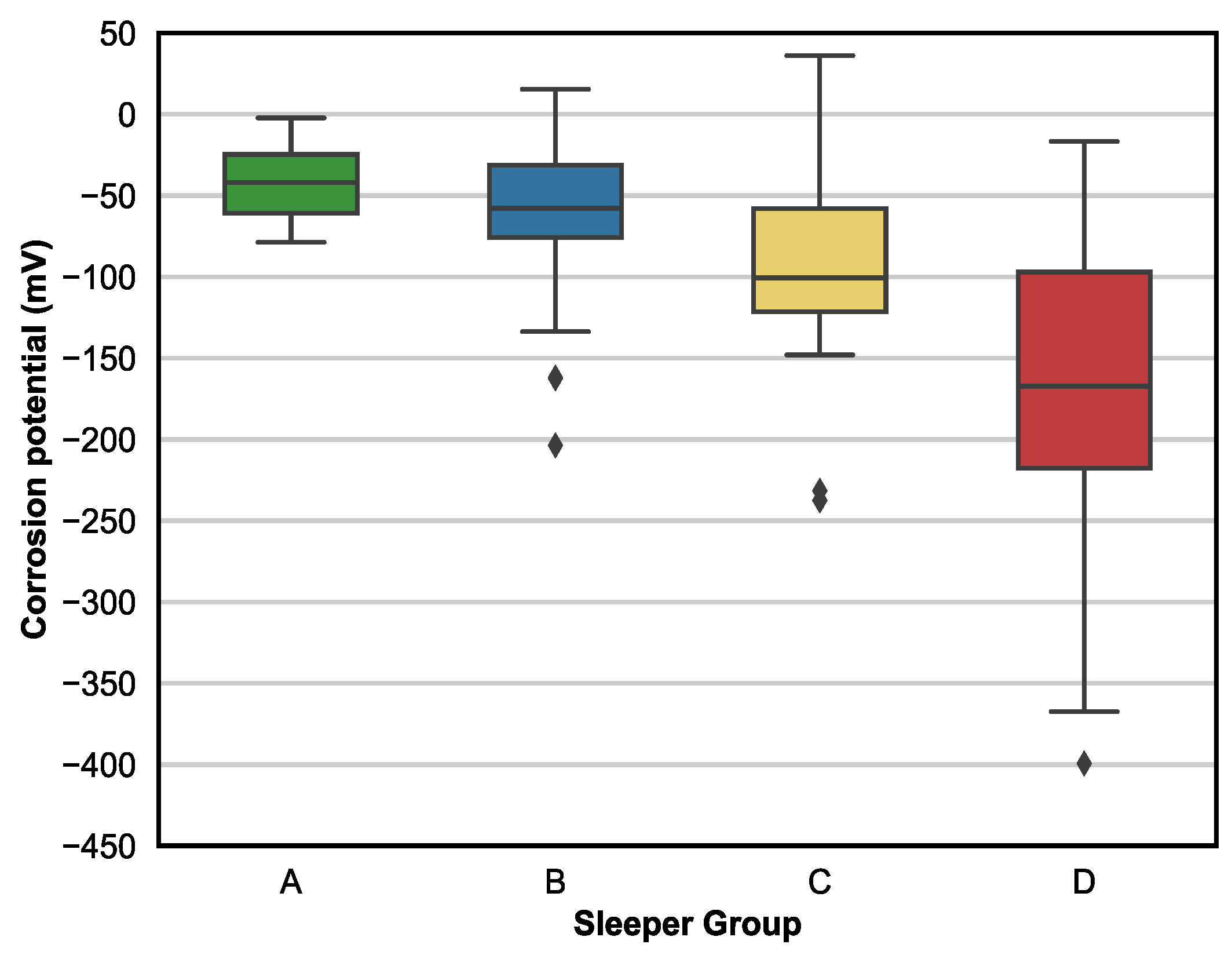
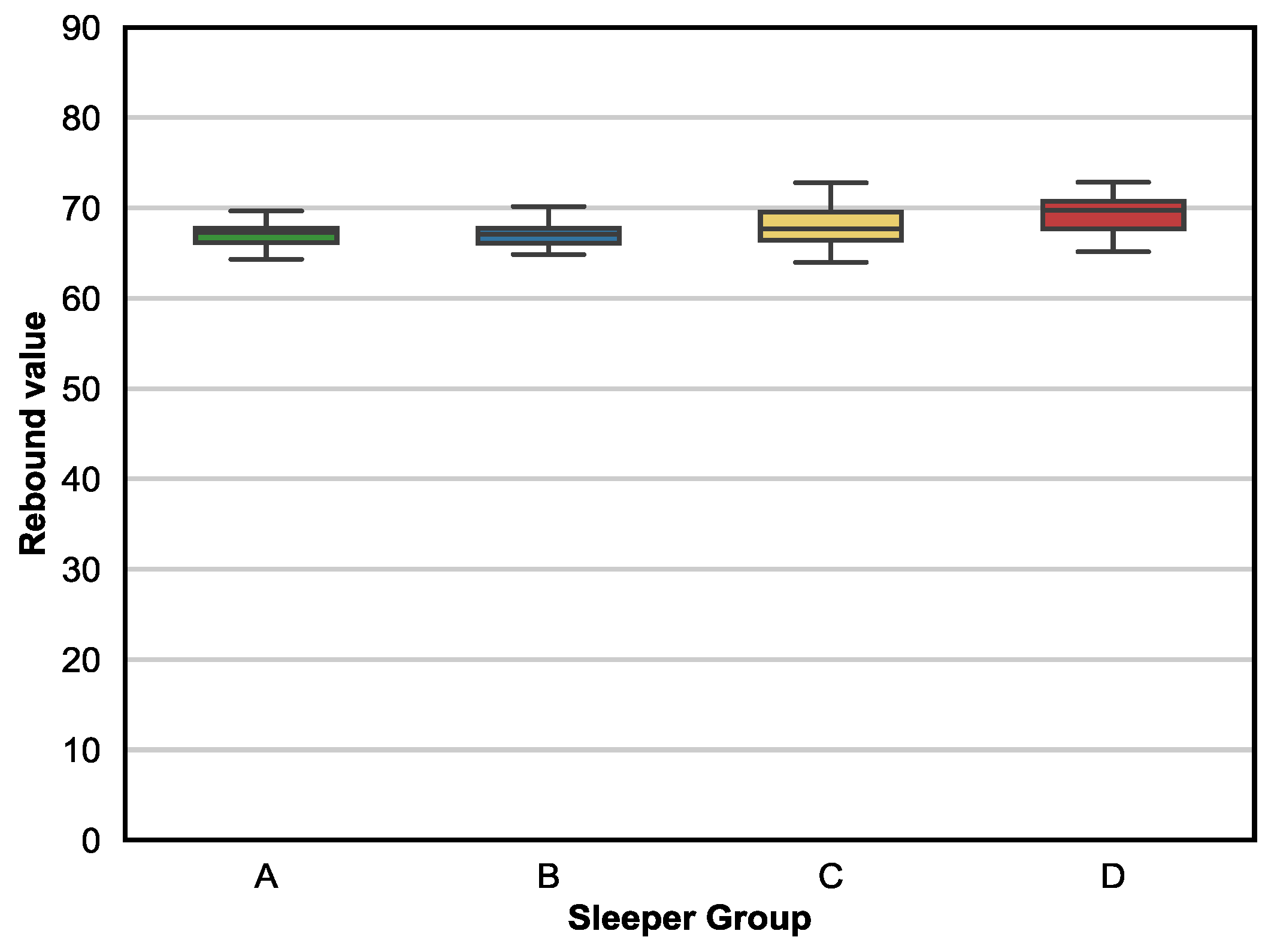

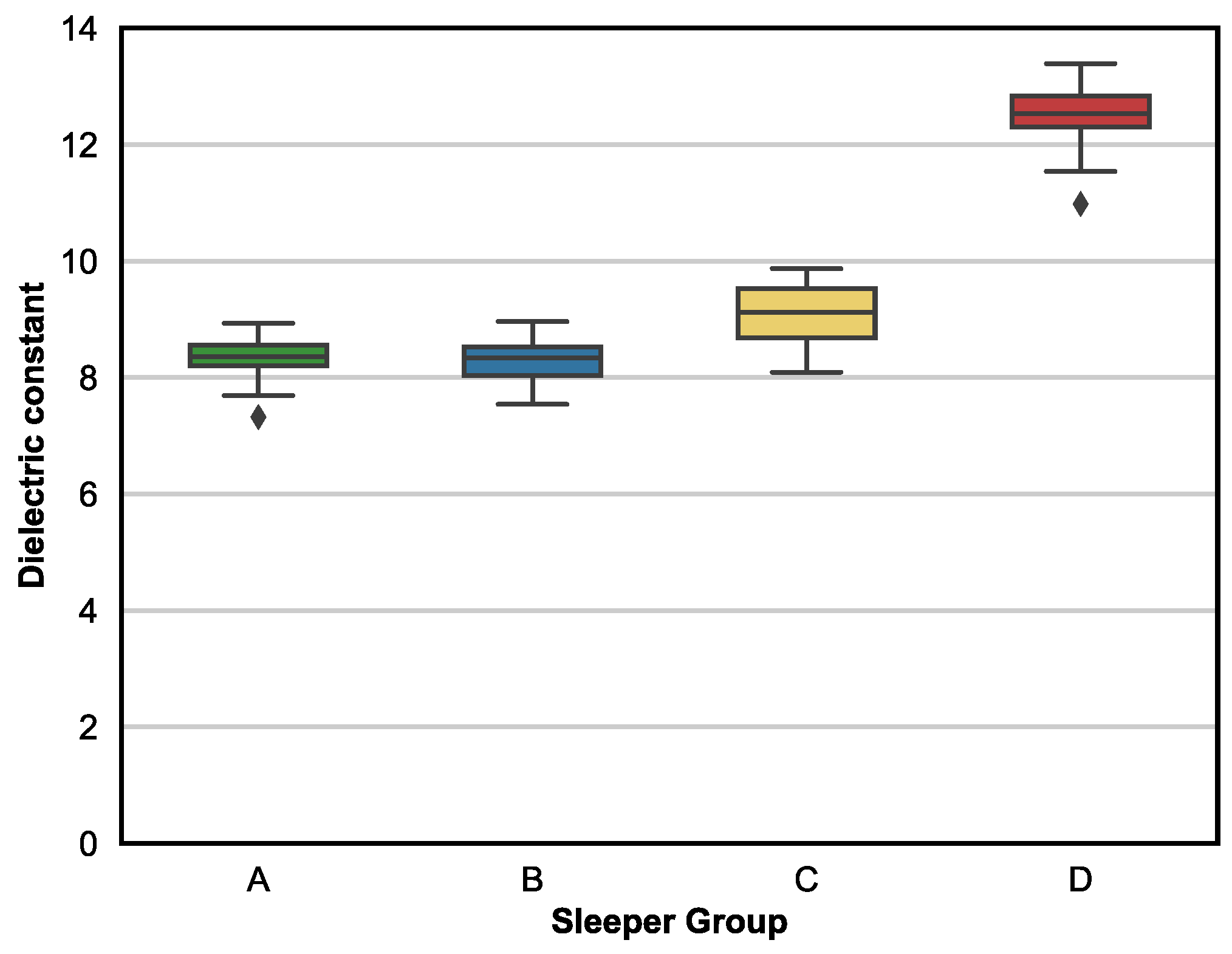


6. Discussion
6.1. Accuracy and Reliability of NDT Methods in Estimating ISR-Induced Damage Level
6.2. Understanding the Sensitivity of NDTs to Detect the Early Stage of ISR-Induced Damage
6.3. Enhancing the Sensitivity in Estimating the Damage Degree in the Early Stage of the ISR-Affected Concrete
7. Conclusions
- Conventional methods, such as the Schmidt hammer and ultrasonic pulse velocity (UPV), although commonly applied in concrete assessment, demonstrated limited sensitivity and reliability in distinguishing ISR-induced damage. Their limited performance is attributed to their reliance on wave transmission and impact rebound, which are not significantly affected when cracks are partially or fully filled with reaction products, such as ASR gel or delayed ettringite. These filling products preserve materials’ continuity and acoustic transmission while preventing impact energy absorption by the cracks, masking the early microstructural changes that precede visible deterioration.
- Electrical and electromagnetic-based techniques, including surface resistivity and ground-penetrating radar (GPR), demonstrated sensitivity to certain levels of ISR-induced deterioration. These methods respond to changes in pore structure, ion mobility, and moisture content, parameters that evolve early in the damage process. Although both were effective in identifying high levels of deterioration, only surface resistivity was able to partially resolve moderate damage levels. Nonetheless, both techniques exhibited limitations in detecting negligible or marginal damage, highlighting a very limited sensitivity.
- Resonant frequency testing emerged as the most reliable NDT method among those investigated. By capturing reductions in natural frequency associated with internal microstructural changes, this technique successfully distinguished between all four levels of damage extent investigated. Furthermore, the decay of the vibration signal provided additional insight into internal energy dissipation, and its quantification through the damping ratio revealed an interesting correlation with key damage parameters such as DRI and SDI. The statistical analyses confirmed the ability of damping to separate even closely related deterioration levels, making it a promising screening parameter for early detection of ISR-induced damage. It is essential to note that validation in real-scale sleepers has yet to be performed.
Author Contributions
Funding
Data Availability Statement
Acknowledgments
Conflicts of Interest
Abbreviations
| Abbreviation | Definition |
| ACI | American Concrete Institute |
| ASR | Alkali-Silica Reaction |
| DEF | Delayed Ettringite Formation |
| DRI | Damage Rating Index |
| GPR | Ground-Penetrating Radar |
| ISR | Internal Swelling Reactions |
| ME | Modulus of Elasticity |
| NDT | Non-Destructive Testing |
| NLI | Non-Linearity Index |
| PDI | Plastic Deformation Index |
| SDI | Stiffness Damage Index |
| SEM | Standard Error of the Mean |
| UPV | Ultrasonic Pulse Velocity |
References
- International Federation for Structural Concrete (fib). Precast Concrete Railway Track Systems; State-of-the-Art Report Prepared by Task Group 6.5, Commission 6 “Prefabrication.” fib Bulletin No. 37; fib: Lausanne, Switzerland, 2006; ISBN 978-2-88394-077-2. ISSN 1562-3610. [Google Scholar]
- Carlsson, S.; Holmbom, E. Process Induced Prestress Losses in long Bed Systems for Railway Sleepers. Master’s Thesis, Chalmers University of Technology, Gothenburg, Sweden, 2012. [Google Scholar]
- Taherinezhad, J.; Sofi, M.; Mendis, P.A.; Ngo, T. A review of behaviour of prestressed concrete sleepers. Electron. J. Struct. Eng. 2013, 13, 1. [Google Scholar] [CrossRef]
- Tepponen, P.; Eriksson, B.E. Damages in Concrete Railway Sleepers in Finland. Nord. Concr. Res. 1987, 6, 199–209. [Google Scholar]
- Mielenz, R.C.; Marusin, S.L.; Hime, W.G.; Jugovic, Z.T. Investigation of prestressed concrete railway tie distress. Concr. Int. 1995, 17, 62–68. [Google Scholar]
- Rogers, C.A.; Tharmabala, T. Prestressed concrete members affected by alkali-silica reaction. ACI Mater. 1990, 12, 35–39. [Google Scholar]
- Qinhua, J.; Min, D.; Sufen, H. Investigation of deteriorated concrete railway ties. Cem. Concr. Res. 1996, 26, 999–1006. [Google Scholar] [CrossRef]
- Shayan, A.; Quick, G.W. Microscopic features of cracked and uncracked concrete railway sleepers. ACI Mater. 1992, 89, 348–361. [Google Scholar] [CrossRef]
- Sahu, S.; Thaulow, N. Delayed ettringite formation in Swedish concrete railroad ties. Cem. Concr. Res. 2004, 34, 1675–1681. [Google Scholar] [CrossRef]
- Silva, A.S.; Gonçalves, A.F.; Pipa, M. Diagnosis and Prognosis of Portuguese Concrete Railway Sleepers Degradation—A Combination of ASR and DEF; ICAAR: Trondheim, Norway, 2008; Volume 2, pp. 1–10. [Google Scholar]
- Petrova, Y.A.; Sorvacheva, T.M. Revisiting the durability of concrete structures. Sci. World 2013, 2, 30. [Google Scholar]
- Awasthi, A.; Matsumoto, K.; Nagai, K.; Asamoto, S.; Goto, S. Investigation on possible causes of expansion damages in concrete. J. Asian Concr. Fed. 2017, 3, 49–66. [Google Scholar] [CrossRef]
- Jokūbaitis, A.; Marčiukaitis, G.; Valivonis, J. Damage of prestressed concrete railway sleepers; its impact on durability. In Proceedings of the 13th International Conference “Modern Building Materials, Structures and Techniques” (MBMST 2019), Vilnius, Lithuania, 16–17 May 2019. [Google Scholar] [CrossRef]
- Medeiros, R.; De Souza, D.J.; Sanchez, L.F.M.; Santos, A.C. Condition assessment of pre-tensioning prestressed concrete sleepers distressed by internal swelling reactions (ISR). CEMENT 2025, 21, 100154. [Google Scholar] [CrossRef]
- Medeiros, R.; Sanchez, L.; Santos, A.C.D. Exploring microscopic and mechanical tools to uncover the anisotropic damage evolution of prestressed concrete sleepers affected by internal swelling reactions. Mag. Concr. Res. 2025, 58. [Google Scholar] [CrossRef]
- Gunn, R.M.; Scrivener, K.L.; Leemann, A. The identification, extent and prognosis of alkali-aggregate reaction related to existing dams in Switzerland. In Swelling Concrete in Dams and Hydraulic Structures; Sellier, É., Grimal, S., Multon, É., Bourdarot, A., Eds.; Wiley: Hoboken, NJ, USA, 2017; pp. 117–143. [Google Scholar]
- Valdes, A. “Renovadora MATISA” Alcançou Mais de 1 Milhão de Dormentes Substituídos. 2021. Available online: https://abifer.org.br/renovadora-matisa-alcancou-mais-de-1-milhao-de-dormentes-substituidos/ (accessed on 17 June 2021).
- Zhang, D.; Zhai, W.; Wang, K.; Liu, P. Vertical Vibration Characteristics of a Concrete Sleeper with Cracks in a Heavy-Haul Railway. In ICTE; American Society of Civil Engineers: Reston, VA, USA, 2015; pp. 1213–1221. [Google Scholar] [CrossRef]
- Diamond, S. A review of alkali-silica reaction and expansion mechanisms and Reactive aggregates. Cem. Concr. Res. 1976, 6, 549–560. [Google Scholar] [CrossRef]
- Rajabipour, F.; Giannini, E.; Dunant, C.; Ideker, J.H.; Thomas, M.D.A. Alkali–silica reaction: Current understanding of the reaction mechanisms and the knowledge gaps. Cem. Concr. Res. 2015, 76, 130–146. [Google Scholar] [CrossRef]
- Leemann, A.; Góra, M.; Lothenbach, B.; Heuberger, M. Alkali silica reaction in concrete—Revealing the expansion mechanism by surface force measurements. Cem. Concr. Res. 2024, 176, 107392. [Google Scholar] [CrossRef]
- Sanchez, L.F.M.; Fournier, B.; Jolin, M.; Duchesne, J. Reliable quantification of AAR damage through assessment of the Damage Rating Index (DRI). Cem. Concr. Res. 2015, 67, 74–92. [Google Scholar] [CrossRef]
- Sanchez, L.F.M.; Fournier, B.; Jolin, M.; Mitchell, D.; Bastien, J. Overall assessment of Alkali-Aggregate Reaction (AAR) in concretes presenting different strengths and incorporating a wide range of reactive aggregate types and natures. Cem. Concr. Res. 2017, 93, 17–31. [Google Scholar] [CrossRef]
- Taylor, H.F.W.; Famy, C.; Scrivener, K.L. Delayed ettringite formation. Cem. Concr. Res. 2001, 31, 683–693. [Google Scholar] [CrossRef]
- Kchakech, B.; Martin, R.-P.; Metalssi, O.O.; Renaud, J.-C.; Baron, L. Effect of temperature and curing duration of early heat treatments on the risk of expansion associated with delayed ettringite formation. In Proceedings of the 15th International Conference on Alkali Aggregate Reaction (ICAAR), São Paulo, Brazil, 3–7 July 2016. [Google Scholar]
- Scrivener, K.; Skalny, J.P. Conclusions of the International RILEM TC 186-ISA Workshop on Internal Sulfate Attack and Delayed Ettringite Formation (4–6 September 2002, Villars, Switzerland). Mater. Struct. 2005, 38, 659–663. [Google Scholar] [CrossRef]
- Martin, R.P. Analyse sur Structures Modèles des Effets Mécaniques de la Réaction Sulfatique Interne du Béton. Ph.D. Thesis, Université Paris Est, Pairs, France, 2010. [Google Scholar]
- Divet, L.; Pavoine, A. Delayed Ettringite Formation in massive concrete structures: An account of some studies of degraded bridges. In International RILEM TC 186-ISA Workshop on Internal Sulfate Attack and Delayed Ettringite Formation; Scrivener, K.L., Skalny, J.P., Eds.; RILEM Publications S.A.R.L.: Villars, Switzerland, 2002; pp. 98–126. [Google Scholar]
- Godart, B.; Omikrine-Metalssi, O.; Kchakech, B.; Lavaud, S. The effects of delayed ettringite formation on the expansion of a massive bridge pier and a precast prestressed concrete beam of a bridge. In Proceedings of the 15th ICAAR, São Paulo, Brazil, 3–7 July 2016. [Google Scholar]
- Sanchez, L.F.M.; Drimalas, T.; Fournier, B.; Mitchell, D.; Bastien, J. Comprehensive damage assessment in concrete affected by different internal swelling reaction (ISR) mechanisms. Cem. Concr. Res. 2018, 107, 284–303. [Google Scholar] [CrossRef]
- Raj, A.; Deshmukh, P.; Pradeepa, S. A Study to Establish Correlation Between Rebound Value and Compressive Strength of Concrete Using Materials Available Locally in Nagpur. Int. J. Res. Advent Technol. 2021, 9, 1–6. [Google Scholar] [CrossRef]
- Malhotra, V.M.; Carino, N.J. Handbook on Nondestructive Testing of Concrete, 2nd ed.; CRC Press (Taylor & Francis Group): Boca Raton, FL, USA, 2003. [Google Scholar]
- ACI Committee. 228.2R-13: Report on Nondestructive Test Methods for Evaluation of Concrete in Structures; American Concrete Institute: Farmington Hills, MI, USA, 2013. [Google Scholar] [CrossRef]
- EN 13791:2019; Assessment of In-Situ Compressive Strength in Structures and Precast Concrete Components. European Committee for Standardization (CEN): Brussels, Belgium, 2019.
- Komlos, K.; Popovics, S.; Nürnbergerová, T.; Babál, B.; Popovics, J.S. Ultrasonic pulse velocity test of concrete properties as specified in various standards. Cem. Concr. Compos. 1996, 18, 357–364. [Google Scholar] [CrossRef]
- Dashti, D. A study of the NDT Techniques Using Ultrasonic Pulse Velocity Test and Microwave Oven Method on SCC and TVC. Master’s Thesis, West Virginia University, Morgantown, WV, USA, 2016. [Google Scholar]
- C666; Test Method for Resistance of Concrete to Rapid Freezing and Thawing. ASTM International Standard: West Conshohocken, PA, USA, 2015.
- Wang, S.; Bai, Y.; Zhang, X.; Fan, L.; Zhou, H. Magnetic Domain-Wall Induced Electric Polarization in NdCrO3 Polycrystalline Ceramic. Materials 2020, 13, 1904. [Google Scholar] [CrossRef] [PubMed]
- Polder, R.B. Test methods for on site measurement of resistivity of concrete—A RILEM TC-154 technical recommendation. Constr. Build Mater. 2001, 15, 125–131. [Google Scholar] [CrossRef]
- Gowers, K.R.; Millard, S.G. Measurement of Concrete Resistivity for Assessment of Corrosion Severity of Steel Using Wenner Technique. ACI Mater. 1999, 96, 536–541. [Google Scholar]
- Morris, W.; Moreno, E.I.; Sagüés, A.A. Practical evaluation of resistivity of concrete in test cylinders using a Wenner array probe. Cem. Concr. Res. 1996, 26, 1779–1787. [Google Scholar] [CrossRef]
- Sansalone, N.J.; Carino, M. Stress wave propagation methods. In Nondestructive Testing of Concrete; Malhotra, N.J., Carino, V.M., Eds.; CRC Press: Boca Raton, FL, USA, 1991. [Google Scholar]
- Subramaniam, K.V.; Popovics, J.S.; Shah, S.P. Determining elastic properties of concrete using vibrational resonance frequencies of standard test cylinders. ACI Mater. 2000, 97, 650–659. [Google Scholar]
- Ahmed, M.S.; Mohammand, F.A. Experimental modal analysis of reinforced concrete square slabs. Civ. Environ. Eng. 2015, 9, 448–452. [Google Scholar]
- Khalil, A.E.-A.; Etman, E.; Atta, A.; Essam, M. Strengthening of rc beams subjected to cyclic load using ultra high-performance strain hardening cementitious composites. Resilient Struct. Sustain. Constr. 2024, 64, 1264–1270. [Google Scholar] [CrossRef]
- Liu, Y.; Zhang, Y.; Wang, Y. Experimental modal analysis of RC beams strengthened with SHCC under cyclic loading. Eng. Struct. 2022, 264, 114459. [Google Scholar]
- Meruane, V.; Yanez, S.J.; Quinteros, L.; Flores, E.I.S. Damage Detection in Steel–Concrete Composite Structures by Impact Hammer Modal Testing and Experimental Validation. Sensors 2022, 22, 3874. [Google Scholar] [CrossRef]
- Sanchez, L.F.M.; Fournier, B.; Mitchell, D.; Bastien, J. Condition assessment of an ASR-affected overpass after nearly 50 years in service. Constr. Build Mater. 2020, 236, 117554. [Google Scholar] [CrossRef]
- Sanchez, L.F.M.; Fournier, B.; Jolin, M.; Bastien, J. Evaluation of the stiffness damage test (SDT) as a tool for assessing damage in concrete due to ASR: Test loading and output responses for concretes incorporating fine or coarse reactive aggregates. Cem. Concr. Res. 2014, 56, 213–229. [Google Scholar] [CrossRef]
- Sanchez, L.F.M.; Fournier, B.; Jolin, M.; Bastien, J.; Mitchell, D. Practical use of the Stiffness Damage Test (SDT) for assessing damage in concrete infrastructure affected by alkali-silica reaction. Constr. Build Mater. 2016, 125, 1178–1188. [Google Scholar] [CrossRef]
- Ewins, D.J.; Testing, M. Theory, Practice and Application; Research Studies Press: Hertfordshire, UK, 2000. [Google Scholar]
- Wei, J.; Dong, J.H.; Ke, W. The influence of cooling processes on the corrosion performance of the rebar scale. Constr. Build Mater. 2010, 24, 275–282. [Google Scholar] [CrossRef]
- Olmos, J.M.; Roesset, B.A. Analytical Evaluation of the Accuracy of the Half-Power Bandwidth Method to Estimate Damping Ratios in a Structure. In Proceedings of the International Conference on Structural Health Monitoring of Intelligent Infrastructure (SHMII-4), Zurich, Switzerland, 22–24 July 2009. [Google Scholar]
- COMITE EURO-INTERNATIONAL DU BETON (CEB). Bulletin D’Information no 192: Diagnosis and Assessment of Concrete Structures. 1989. Available online: https://www.fib-international.org/publications/ceb-bulletins/diagnosis-and-assessment-of-concrete-structures-detail.html (accessed on 20 May 2021).
- Whitehurst, E.A. Evaluation of Concrete Properties from Sonic Tests; The Iowa State University Press: Ames, IA, USA, 1966. [Google Scholar]
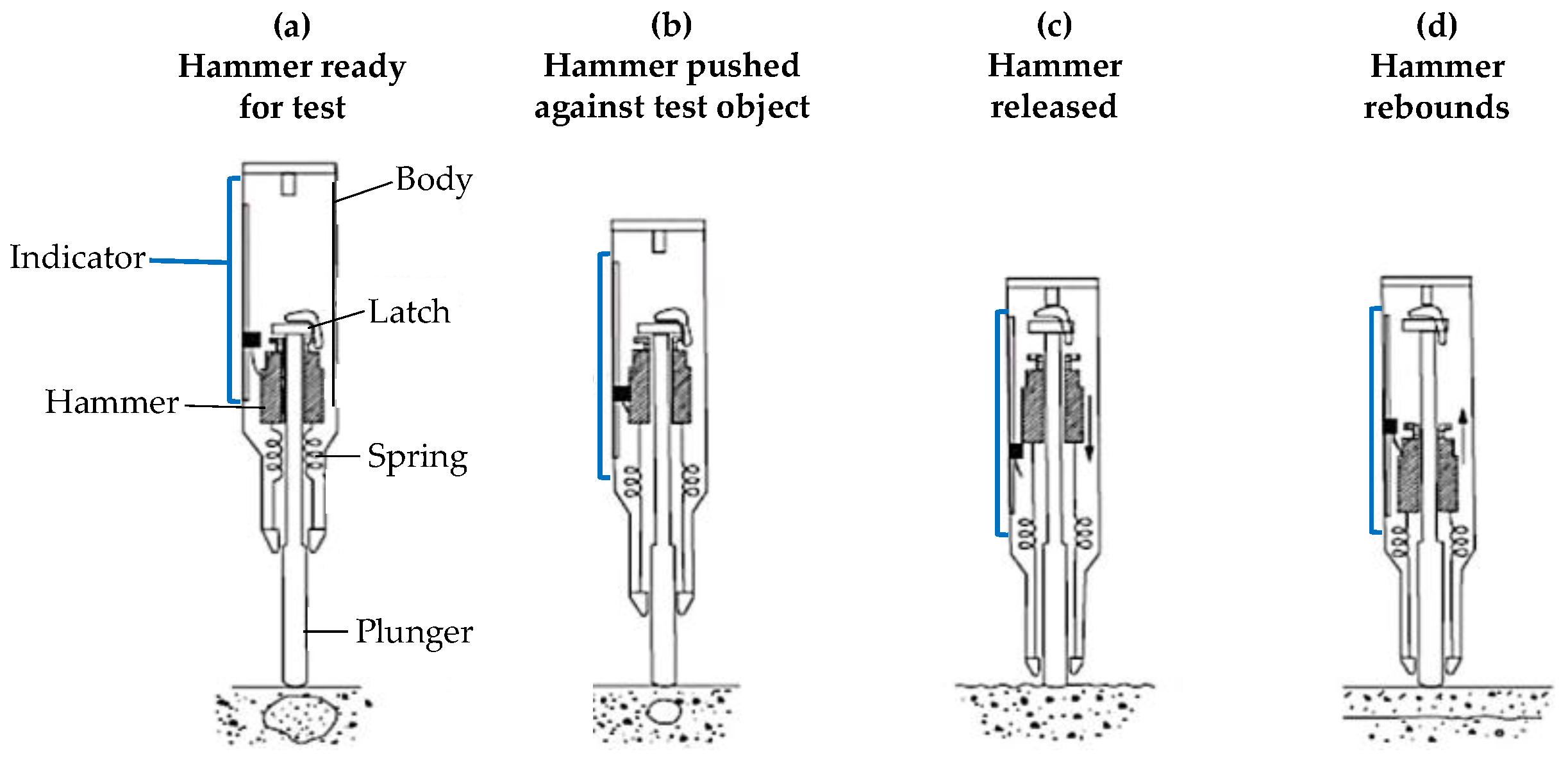

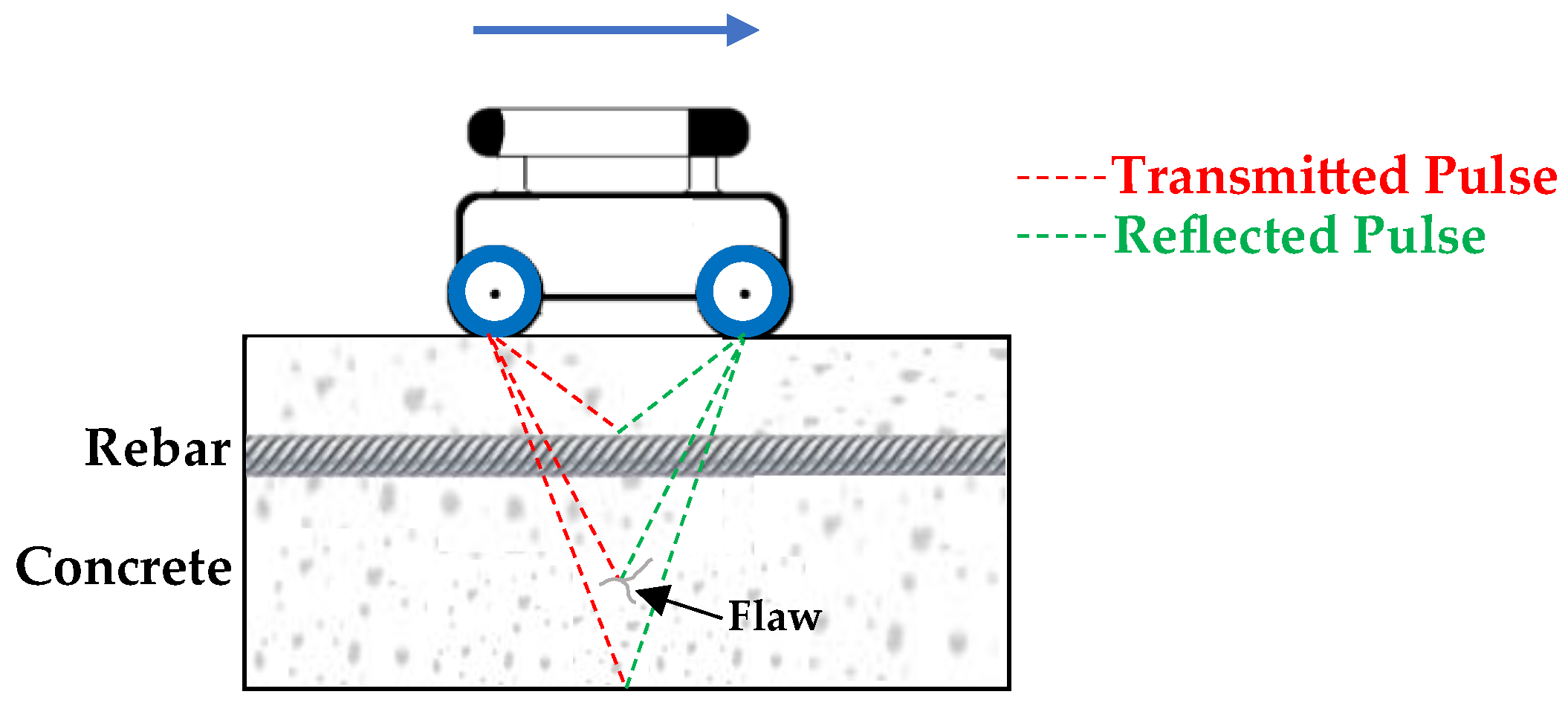
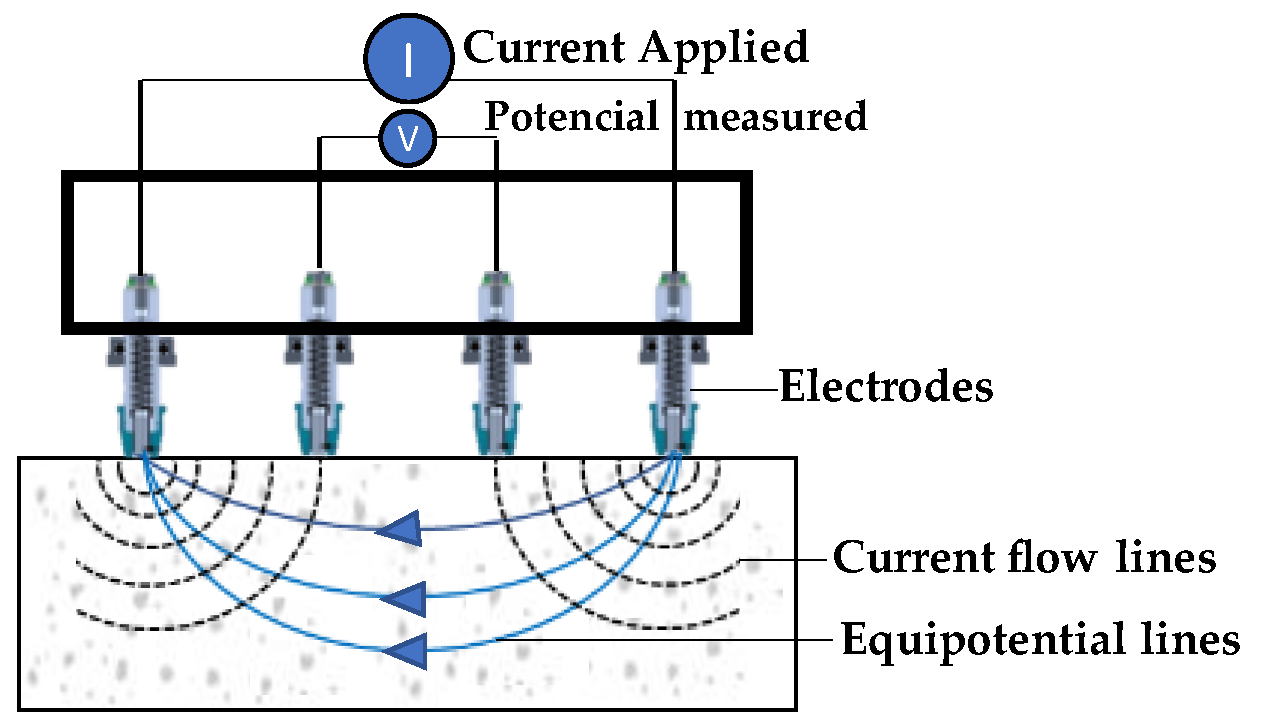
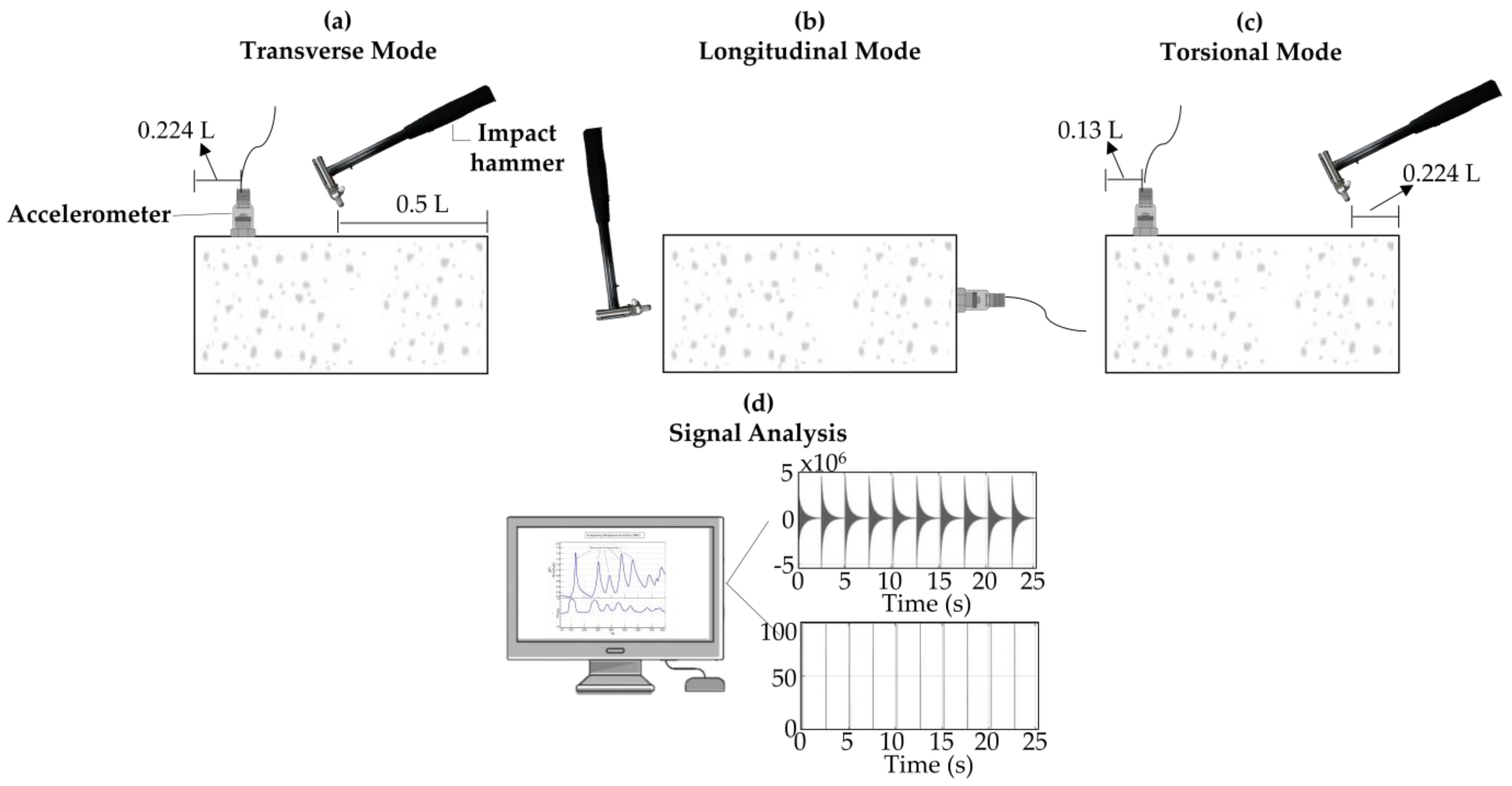
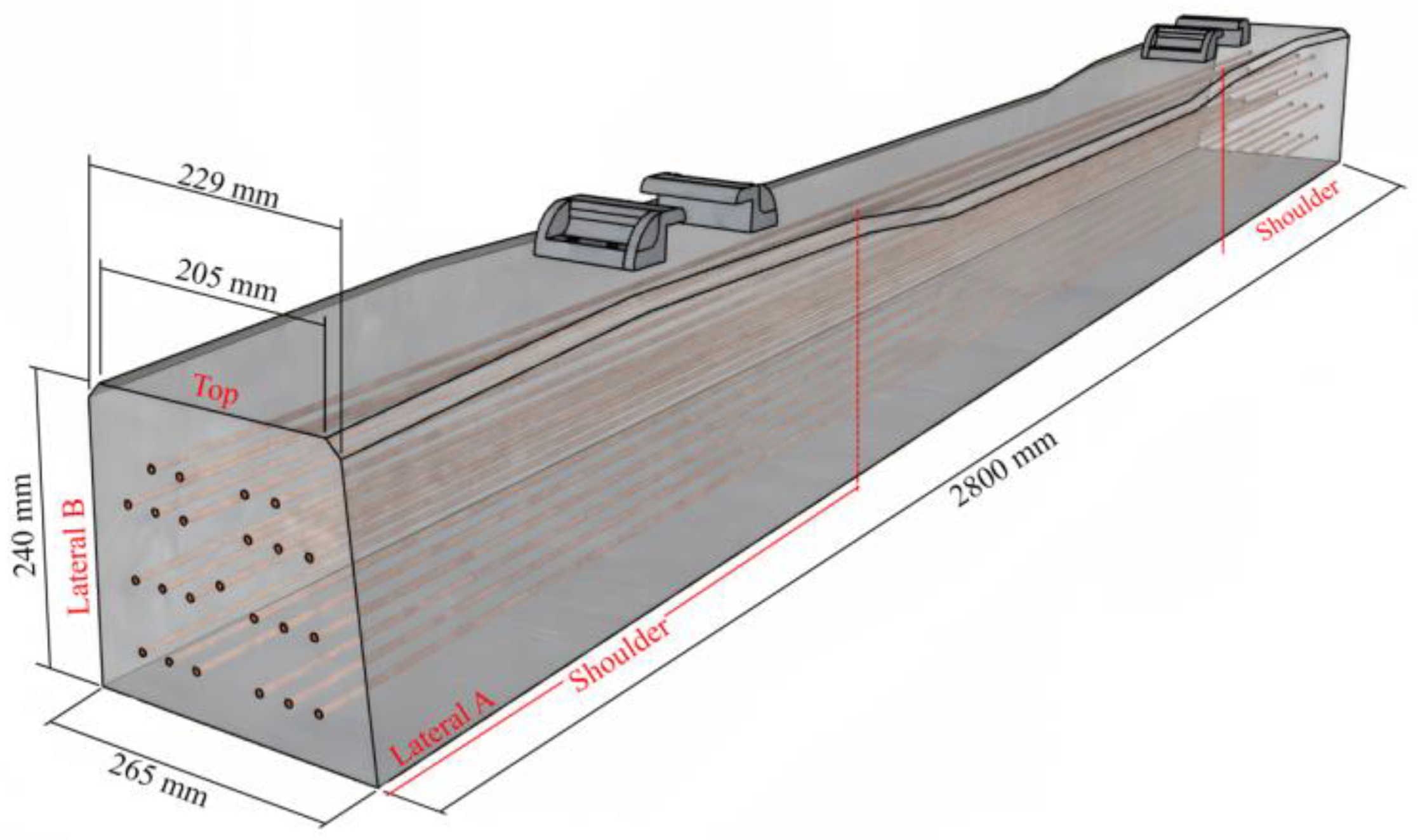
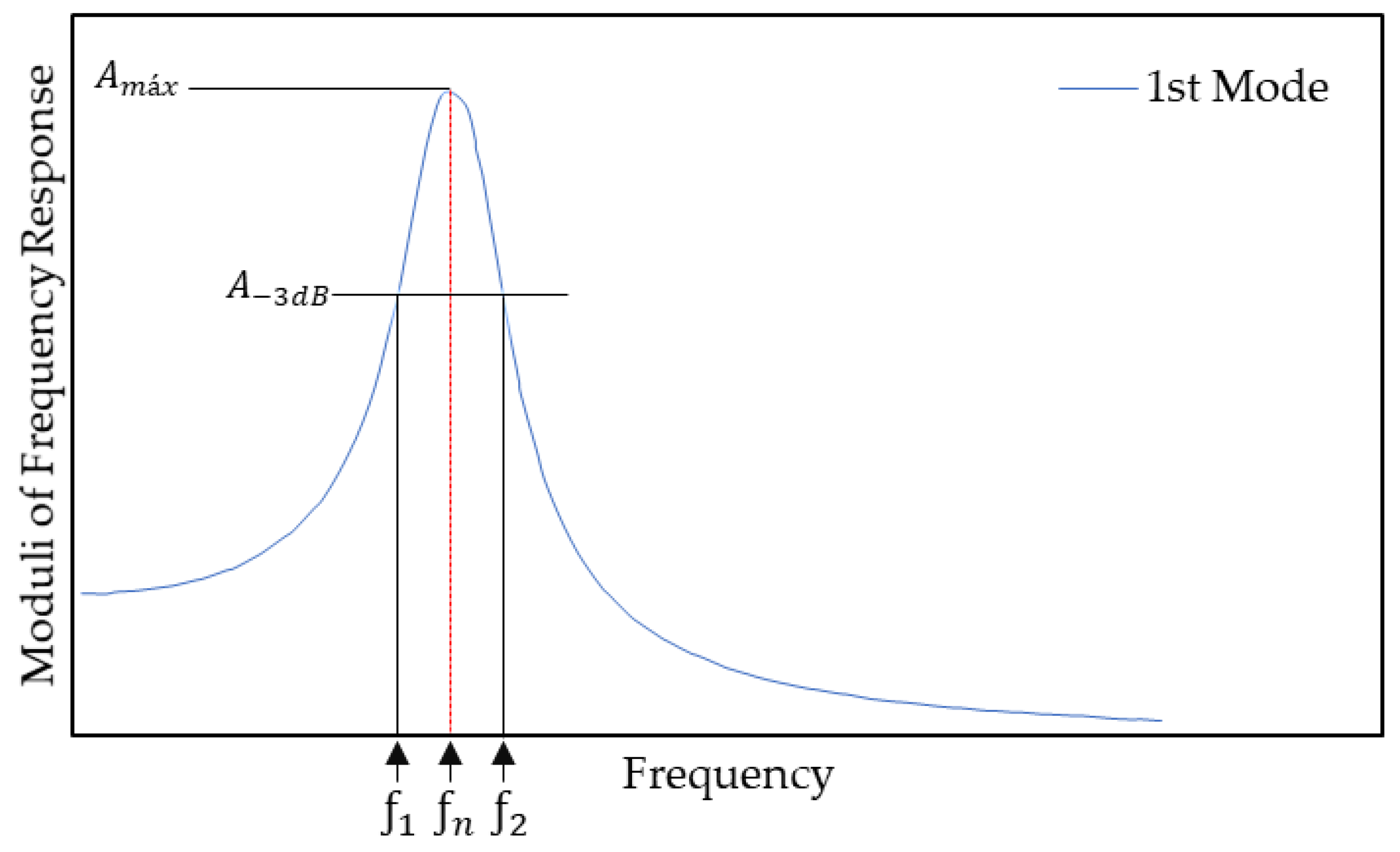
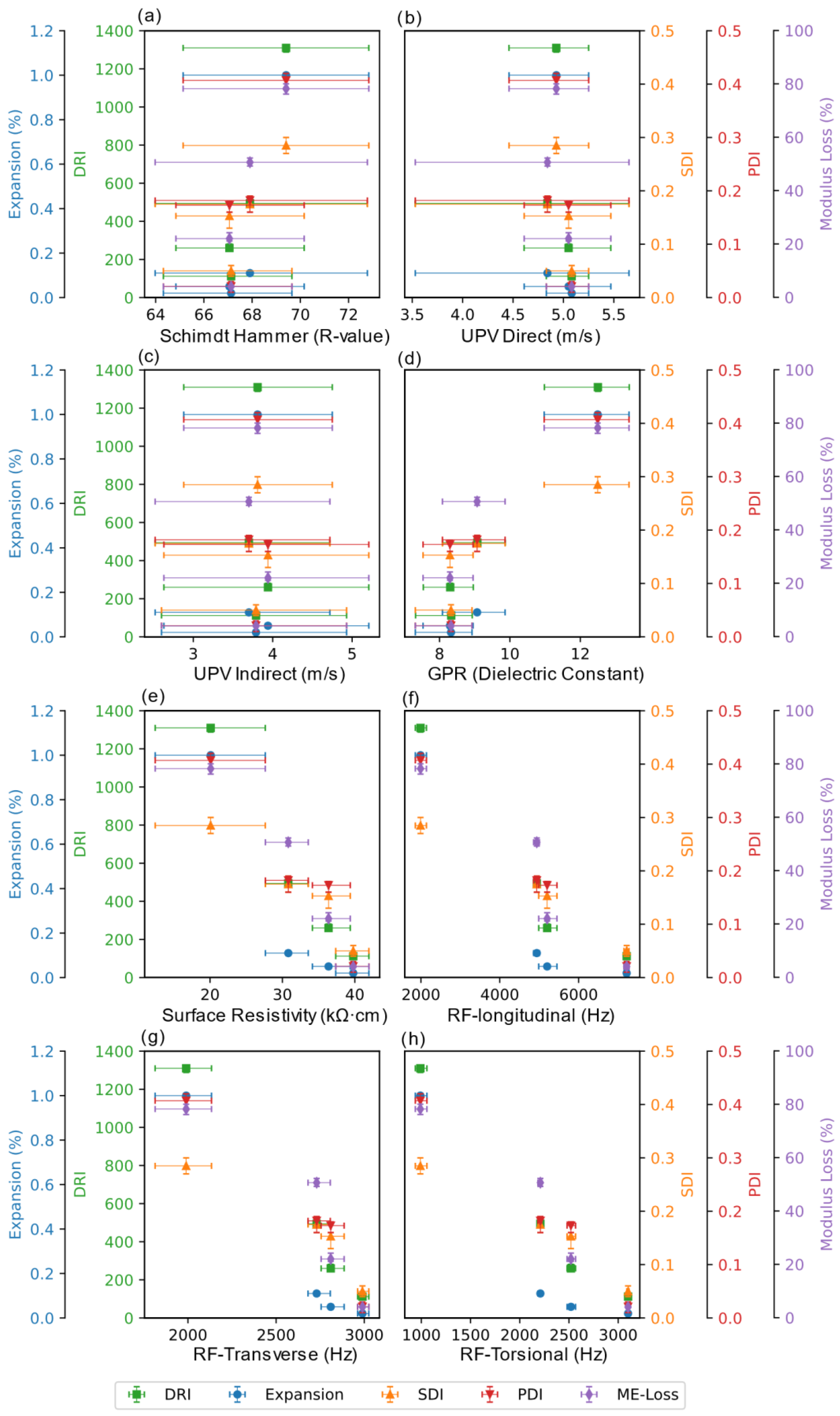
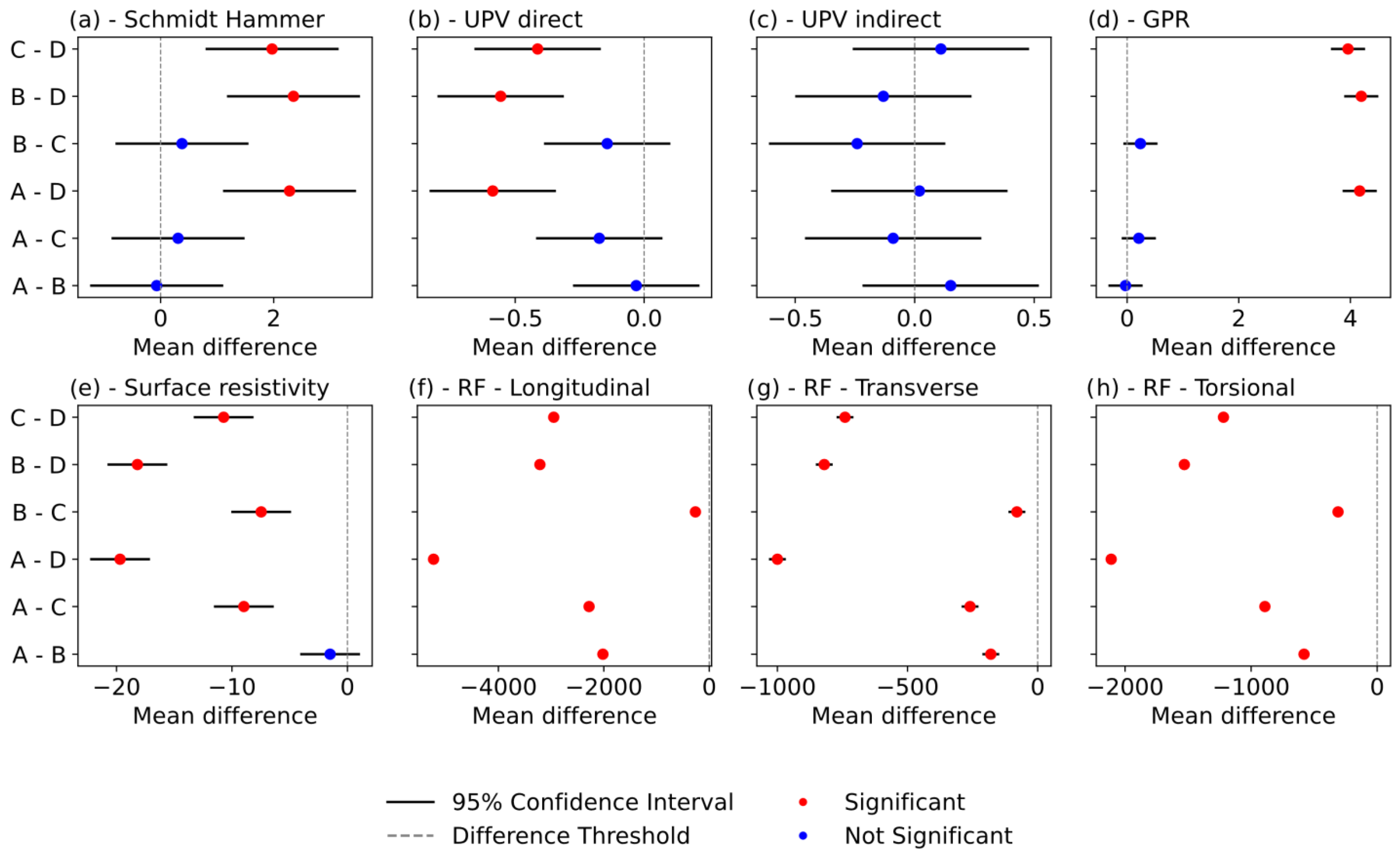
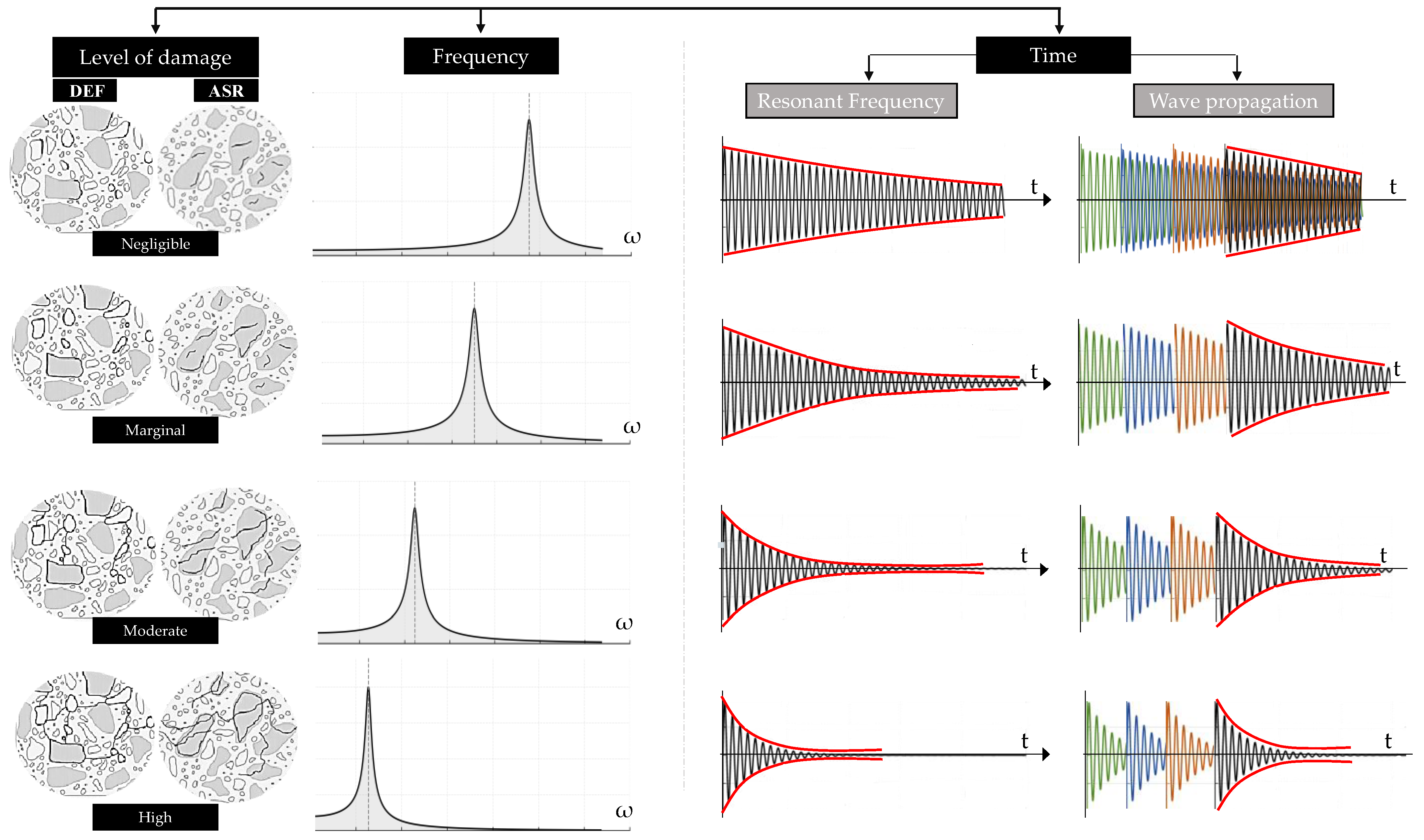

| Distress Mechanism | Classification of Damage Degree | Reference Level of Expansion (%) a | Damage Results | ||||
|---|---|---|---|---|---|---|---|
| Stiffness Loss (%) | Compressive Strength Loss (%) | Tensile Strength Loss (%) | SDI | DRI | |||
| ASR | Negligible | 0.00–0.03 | – | – | – | 0.06–0.16 | 100–155 |
| Marginal | 0.04 ± 0.01 | 5–37 | (−)10–15 | 15–60 | 0.11–0.25 | 210–400 | |
| Moderate | 0.11 ± 0.01 | 20–50 | 0–20 | 40–65 | 0.15–0.31 | 330–500 | |
| High | 0.20 ± 0.01 | 35–60 | 13–25 | 45–80 | 0.19–0.32 | 500–765 | |
| Very high | 0.30 to 0.50 ± 0.01 | 40–67 | 20–35 | – | 0.22–0.36 | 600–925 | |
| Ultra-high | 0.50 to 1.00 ± 0.01 | – | – | – | – | – | |
| DEF and DEF + ASR | Negligible | 0.00–0.03 | – | – | – | 0.11 | 110–147 |
| Marginal | 0.04 ± 0.01 | – | – | – | – | – | |
| Moderate | 0.11 ± 0.01 | 35–56 | 9–34 | – | 0.17–0.20 | 355–599 | |
| High | 0.20 ± 0.01 | – | – | – | – | – | |
| Very high | 0.30 to 0.50 ± 0.01 | 55–62 | 29–43 | – | 0.19–0.28 | 623–710 | |
| Ultra-high | 0.50 to 1.00 ± 0.01 | 56–77 | 40–47 | – | 0.27–0.43 | 828–1022 | |
| – | ≥1.00 ± 0.01 | 60–86 | 40–50 | – | 0.30–0.54 | 841–1363 | |
| Sleeper Group | Age (Years) | Microscopic | Mechanical | Damage Degree Estimation | ||||
|---|---|---|---|---|---|---|---|---|
| DRI Nº | SDI | PDI | NLI | ME | ||||
| A | 1 | 112 | 0.05 | 0.02 | 0.65 | 28.78 | 0.00–0.03% | Negligible |
| B | 6 | 260 | 0.15 | 0.17 | 0.62 | 23.38 | 0.04 ± 0.01% | Marginal |
| C | 11 | 494 | 0.18 | 0.18 | 1.00 | 14.8 | 0.11 ± 0.01% | Moderate |
| D | 12 | 1310 | 0.29 | 0.41 | 1.02 | 6.5 | ≥1.00 | ↑ Ultra-high |
| Source | SS | df | MS | F_Value | F_0.05 | p_Value | Significant |
|---|---|---|---|---|---|---|---|
| Schmidt Hammer | 111.37 | 3 | 37.12 | 12.61 | 2.68 | 3.43 × 10−7 | Yes |
| Residual | 341.57 | 116 | 2.94 | ||||
| UPV Direct | 6.57 | 3 | 2.19 | 17.17 | 2.68 | 2.70 × 10−9 | Yes |
| Residual | 14.80 | 116 | 0.13 | ||||
| UPV Indirect | 0.89 | 3 | 0.30 | 1.01 | 2.68 | 3.90 × 10−1 | No |
| Residual | 33.90 | 116 | 0.29 | ||||
| Surface Resistivity | 380.41 | 3 | 126.80 | 710.13 | 2.68 | 1.90 × 10−74 | Yes |
| Residual | 20.71 | 116 | 0.18 | ||||
| GPR Dielectric Constant | 7289.66 | 3 | 2429.89 | 178.11 | 2.68 | 2.97 × 10−43 | Yes |
| Residual | 1582.55 | 116 | 13.64 | ||||
| RF—Longitudinal | 417,835,754.94 | 3 | 139,278,584.98 | 22,533.68 | 2.68 | 3.12 × 10−160 | Yes |
| Residual | 716,985.33 | 116 | 6180.91 | ||||
| RF—Transverse | 17,446,495.93 | 3 | 5,815,498.64 | 3430.24 | 2.68 | 4.67 × 10−113 | Yes |
| Residual | 196,662.22 | 116 | 1695.36 | ||||
| RF—Torsional | 71,284,419.33 | 3 | 23,761,473.11 | 71,681.93 | 2.68 | 2.37 × 10−189 | Yes |
| Residual | 38,452.24 | 116 | 331.48 |
| One-Way ANOVA | ||||||||
| Source | SS | df | MS | F_Value | F_0.05 | p_Value | Significant | |
| Damping | 82.61 | 3 | 27.54 | 284.99 | 2.76 | 1.92 × 10−35 | Yes | |
| Residual | 5.80 | 60 | 1.00 | |||||
| Tukey HSD post hoc | ||||||||
| Group 1 | Group 2 | Mean Difference | Lower | Upper | p_Value | Significant | ||
| A | B | 0.7014 | 0.4110 | 0.9918 | 0.0005 | Yes | ||
| A | C | 1.1594 | 0.8690 | 1.4498 | 0.0006 | Yes | ||
| A | D | 3.0646 | 2.7742 | 3.3550 | 0.0006 | Yes | ||
| B | C | 0.4580 | 0.1676 | 0.7484 | 0.0006 | Yes | ||
| B | D | 2.3632 | 2.0728 | 2.6536 | 0.0006 | Yes | ||
| C | D | 1.9052 | 1.6148 | 2.1956 | 0.0005 | Yes | ||
Disclaimer/Publisher’s Note: The statements, opinions and data contained in all publications are solely those of the individual author(s) and contributor(s) and not of MDPI and/or the editor(s). MDPI and/or the editor(s) disclaim responsibility for any injury to people or property resulting from any ideas, methods, instructions or products referred to in the content. |
© 2025 by the authors. Licensee MDPI, Basel, Switzerland. This article is an open access article distributed under the terms and conditions of the Creative Commons Attribution (CC BY) license (https://creativecommons.org/licenses/by/4.0/).
Share and Cite
Medeiros, R.; Guedes, M.E.; Sanchez, L.; dos Santos, A.C. Reliability of Non-Destructive Testing for Appraising the Deterioration State of ISR-Affected Concrete Sleepers. Buildings 2025, 15, 2975. https://doi.org/10.3390/buildings15162975
Medeiros R, Guedes ME, Sanchez L, dos Santos AC. Reliability of Non-Destructive Testing for Appraising the Deterioration State of ISR-Affected Concrete Sleepers. Buildings. 2025; 15(16):2975. https://doi.org/10.3390/buildings15162975
Chicago/Turabian StyleMedeiros, Rennan, Maria Eduarda Guedes, Leandro Sanchez, and Antonio Carlos dos Santos. 2025. "Reliability of Non-Destructive Testing for Appraising the Deterioration State of ISR-Affected Concrete Sleepers" Buildings 15, no. 16: 2975. https://doi.org/10.3390/buildings15162975
APA StyleMedeiros, R., Guedes, M. E., Sanchez, L., & dos Santos, A. C. (2025). Reliability of Non-Destructive Testing for Appraising the Deterioration State of ISR-Affected Concrete Sleepers. Buildings, 15(16), 2975. https://doi.org/10.3390/buildings15162975






